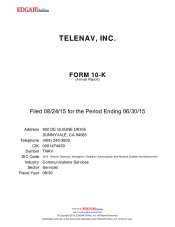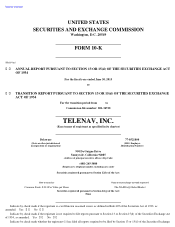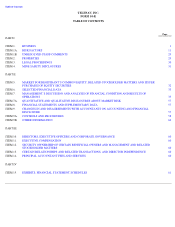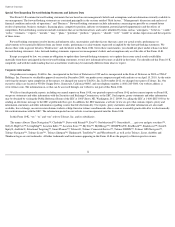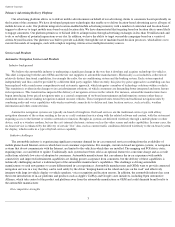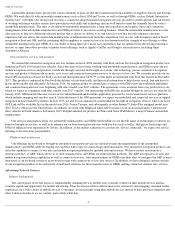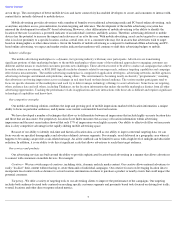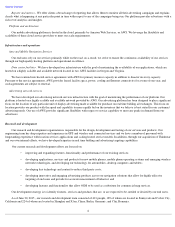TeleNav 2015 Annual Report Download - page 7
Download and view the complete annual report
Please find page 7 of the 2015 TeleNav annual report below. You can navigate through the pages in the report by either clicking on the pages listed below, or by using the keyword search tool below to find specific information within the annual report.
Table of Contents
marketplaces. Our wireless carrier customers pay us based on several different revenue models, including (1) a revenue sharing arrangement that
may include a minimum fee per end user, (2) a monthly or annual subscription fee per end user, or (3) based on usage.
Our fiscal year ends June 30. In this Form 10-K, we refer to the fiscal year ended June 30, 2013, 2014, 2015 and 2016 as fiscal 2013, fiscal
2014, fiscal 2015 and fiscal 2016, respectively. Our total revenue was $191.8 million in fiscal 2013, $150.3 million in fiscal 2014 and $160.2
million in fiscal 2015. Our net income decreased from $13.1 million in fiscal 2013 to a net loss of $(29.5) million in fiscal 2014 and a net loss of
$(23.1) million in fiscal 2015. On April 16, 2013, we completed the sale of our enterprise business to a third party. The results of operations of
our enterprise business have been classified as discontinued operations in our statement of operations for all periods presented through fiscal
2013. All information herein includes only results from continuing operations, unless otherwise noted.
Auto and Mobile Navigation Services Platform
Our map and navigation platform was originally developed to target mobile devices with real-time directions and information about places
near the user’s mobile device. More recently, we have evolved our platform so that it is primarily targeted to deliver solutions for automotive
manufacturers and OEMs. We have also enhanced our solutions to make them better suited for the in-car experience.
We have developed proprietary technologies that enable us to provide location-based mapping and navigation services. These technologies
include both client-based and cloud-based services. Our client technologies include a navigation and guidance engine and tools allowing us to
efficiently develop and deploy new applications to mobile phones and in vehicles. Our back-end cloud services technologies allow us to deliver
real-time location-based data for users and third party software developers that adopt our software development kit, or SDK, and application
protocol interfaces, or APIs. We have developed a flexible platform that allows us to use multiple data providers for navigation, maps, points of
interest, or POIs, traffic and other location-based content services.
In January 2014, we acquired skobbler GmbH, or skobbler, a leading provider of technologies that enhance the Open Street Map, or OSM,
mapping data. By combining these technologies with other proprietary Telenav technologies, we have developed a range of OSM capabilities
that allow us to use these crowd sourced maps for more advanced services such as navigation. We believe that focusing our efforts on OSM will
better position us relative to our competitors and expand the nature and extent of our product offerings.
Our software and client application development processes, which include design, porting and publication processes, allow us to extend our
services effectively and efficiently to different automobiles across various automotive platforms and in-car electronic systems to meet the
requirements of automobile manufacturers and OEMs for our on-board and brought-in automotive products.
Our back-
end cloud technologies include our Geographic Information System, or GIS, engines for local search, voice recognition, geo alert
and advanced geo data aggregation, traffic and a local advertising platform. We have developed customized voice recognition technology built
upon a third party voice recognition engine to serve the specific needs of navigation services customers. We leverage our existing back-end
cloud technologies for deployment to automobile manufacturer and OEM solution applications. We utilize existing technology to expand the
connectivity and service offerings for in-car experiences, including seamless interaction between end users' mobile devices and on-board
automobile systems such as displays, sensors and audio for our automotive brought-in navigation solutions.
We have developed a search technology that focuses on information with localized relevance and accuracy to address the needs of
automotive and mobile phone users. Our proprietary GIS provides fast route and map generation while optimizing the route based on current
traffic conditions. Because our proprietary GIS efficiently uses computing resources, these efficiencies enable us to scale our servers more
economically for our automotive brought-in solutions.
In addition to our automotive navigation services, we offer our map and navigation platform to mobile phone users in a number of ways.
We distribute our services through our wireless carrier partners, including AT&T Mobility LLC, or AT&T, and directly to consumers through
mobile application stores and marketplaces. We distribute our premium services under wireless carrier brands (or “white label” brands). We
provide our basic services directly to mobile phone users for free and provide these users with the opportunity to purchase premium versions of
the product. We refer to the free to premium distribution as the “freemium” model of distribution. Our free products are designed to be
monetized through delivery of advertising to mobile phone users through our application. Our success with the freemium model depends upon
our ability to generate a substantial active user base, place ads to those mobile phone users and convert those users from free to premium
services.
2

